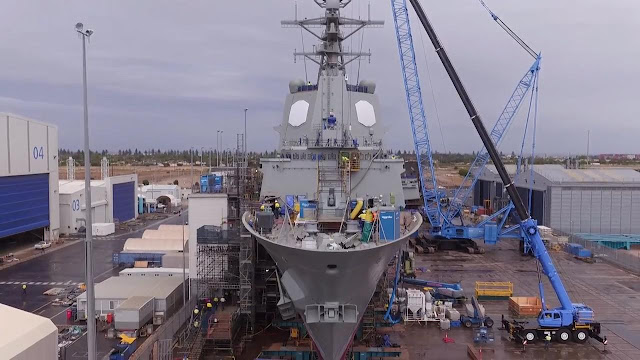Australia's security brief was relatively easy when Australia was "deputy sheriff" of the "Arc of Instability" (islands from East Timor through PNG, Solomons to Fiji) up until about 2008. But now Australia's role is even more complex with broader problems, including North Korea terrorising northeast Asia and China coveting the entire Indo-Pacific Region.
---
AUSTRALIA INCREASING NAVAL EXERCISES
In August 2017 Australian personnel took part in joint US-Korean military exercises
Exercise Haedoli Wallaby
In solidarity with South Korea (considering the North Korean threat) Australian frigatesHMAS Melbourne and HMAS Parramattawill be making port visits to South Korea and conducting "Haedoli Wallaby" exercises with the South Korean Navy in late October 2017. "Haedoli" means "dolphin" in Korean.
Exercise Indo-Pacific Endeavor 2017
China would be aware that Australia is in touch with other countries in the region. During September to November 2017 HMAS Melbourne and Parramatta are also participating in a more widespread Indo-Pacific Endeavor 2017. Australian participants also include the newly commissioned landing helicopter dock HMAS Adelaide (photo below) - also the frigates HMAS Darwin, HMAS Toowoomba and replenishment ship HMAS Sirius. This is the largest Australian naval exercise in 40 years and involves visits to and/or interaction with naval forces from Indonesia, Japan, Malaysia, the Philippines, Brunei, Cambodia, Micronesian Islands, India, again South Korea, Singapore, Thailand and East Timor. More at The Diplomat (paysite).
The Australian vessels are also exercising with those US destroyers that are still undamaged in the region.
AUSTRALIAN-SOUTH KOREAN DIPLOMACY
In the face of the North Korean threat Australia is taking other measures in solidarity with South Korea.
The third ROK-Australian 2 + 2 meeting in Seoul is being held on October 12 and 13, 2017. This is between Australia’s Foreign Minister Julie Bishop and Defence Minister Marise Payne with their South Korean counterparts. Here is the Australian Ministers’ Joint Media Release.
It is highly likely that if North Korea attacked US forces in South Korea, in Japan/Okinawa or US forces at sea this would invoke the ANZUS Treaty. US and probably Australian forces would then be fighting against North Korea. See more at the (Australian) ABC News article by Andrew Greene.
Growing in size and becoming more active. Landing Helicopter Dock ships HMAS Canberra and HMAS Adelaide as well as smaller Royal Australia Navy vessels at Fleet Base East (Sydney). (Photo courtesy Australia in the Great War)
---
Pete
















